Latrodectus hesperus, the Western black widow spider is one of the few medically significant venomous spiders in the United States. As its common name suggests, it can be found in the Western States of the US as well as in Canada.
Description of the Western Black Widow
The larger female Western black widow looks very similar to the Northern black widow and the Southern black widow female. The best indicator for a western black widow is the geographic location. If you spot a black widow spider in California or on the Northern Pacific Coast, you are most likely looking at a Western widow spider.
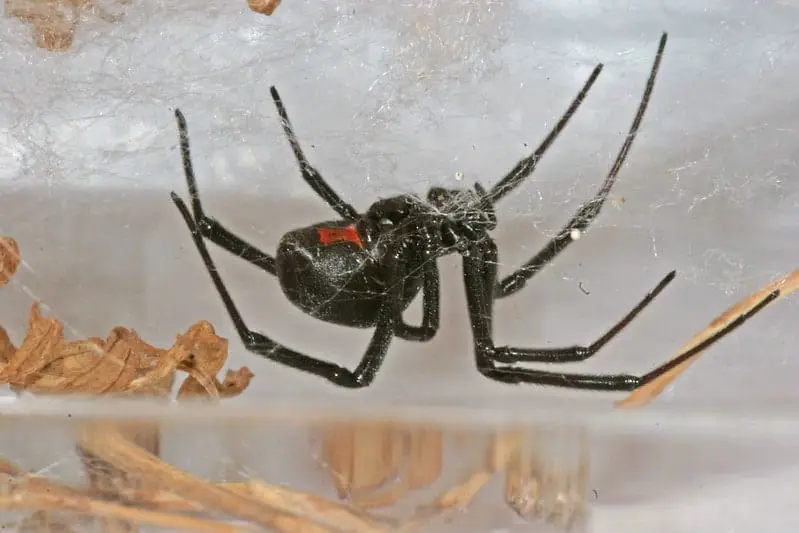
The adult female western black widow has a completely black and shiny body with an orange or red hourglass-shape at the bottom. The hourglass is complete and not broken in the middle as is the case for the northern black widow.
The immature female’s body is often very dark brown instead of completely black. While the hourglass at the dorsal side of the abdomen is already visible, the upper side of the abdomen has some brown and yellow markings.
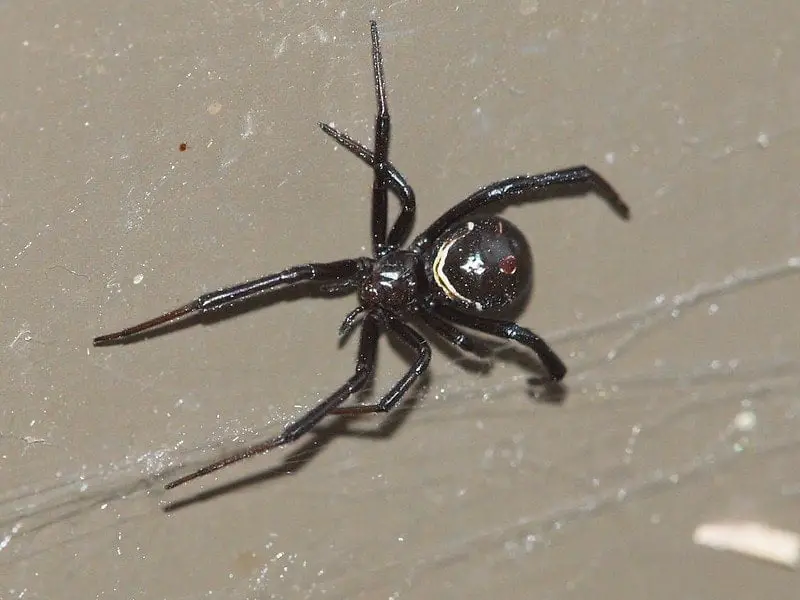
The male is considerably smaller than the female and its body is brown and olive green with orange markings on its abdomen. Juvenile and male black widows do not inject enough venom with a bite to cause serious medical effects.
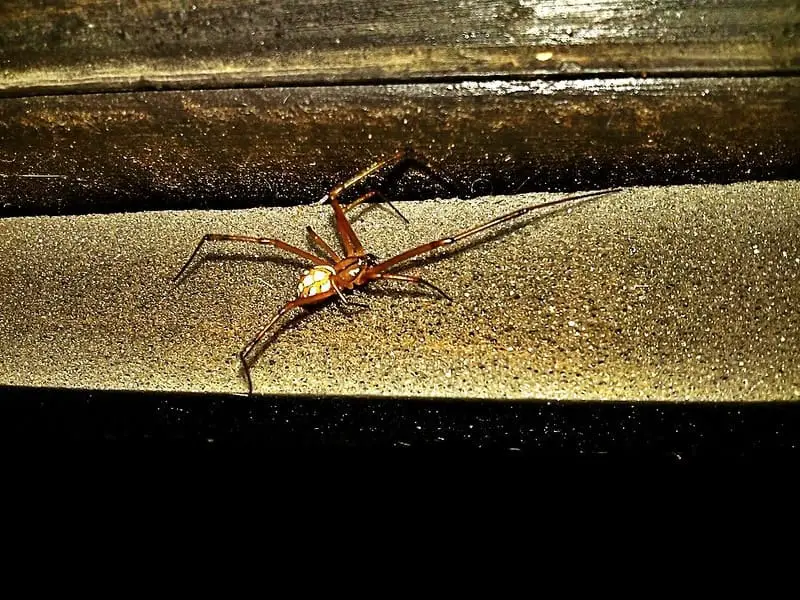
Western black widows are often confused with the closely related Steatoda grossa spider which led to its common name false black widow. Especially in California, the Steatoda grossa population has exploded over the last years leading to many mistaken identifications.
Size
All North American widow spiders are roughly the same size. The adult female black widow grows to about half an inch (13 mm). They can reach a total leg span of 1.5-2 inches (38-50 mm).
Web
Widow spiders create very erratic webs. Mostly, the webs can be found in corners and look like loose strands of web. The female will spend most of its time in or very close to the web. If you see an unprofessionally looking, small web, you might be dealing with a widow spider. Don’t reach out to touch the web with your hands. This might scare the spider and cause it to attack. Especially if the web contains egg sacs. Most of the reported black widow bites occur to the limbs, especially hands.
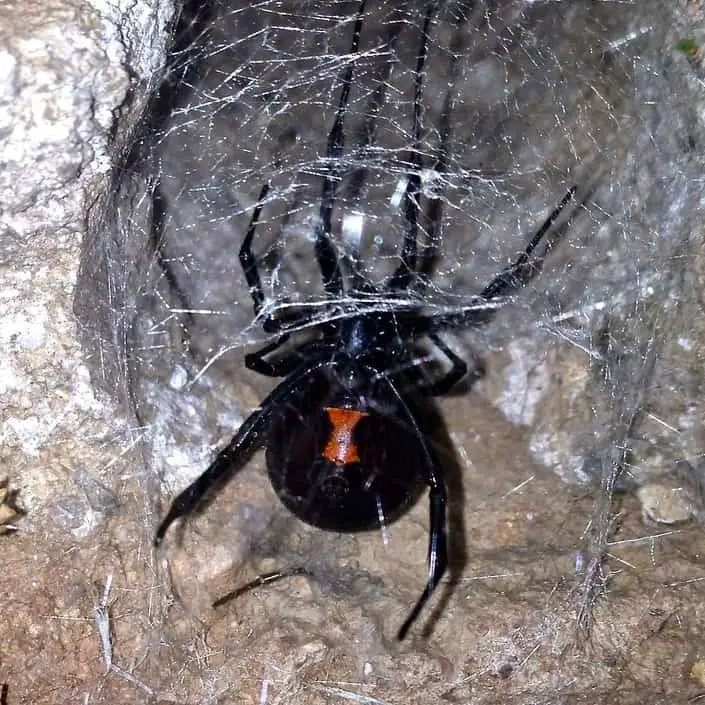
Western Black Widow Bite
Western black widows aren’t aggressive spiders. Most likely, it will run away from you before it would even get the chance to bite you. However, if the spider feels trapped or attacked, it might feel no other option than to bite. Black widows often bite without injecting any venom into the target. This means that the bite is harmless apart from the mild pain from the actual bite. We still recommend visiting a doctor or a hospital if you have been bitten by a female black widow spider. Even though some bites feel minor at first, the venom can cause nausea, vomiting and other symptoms after some time.
Range of the Western Widow in the United States
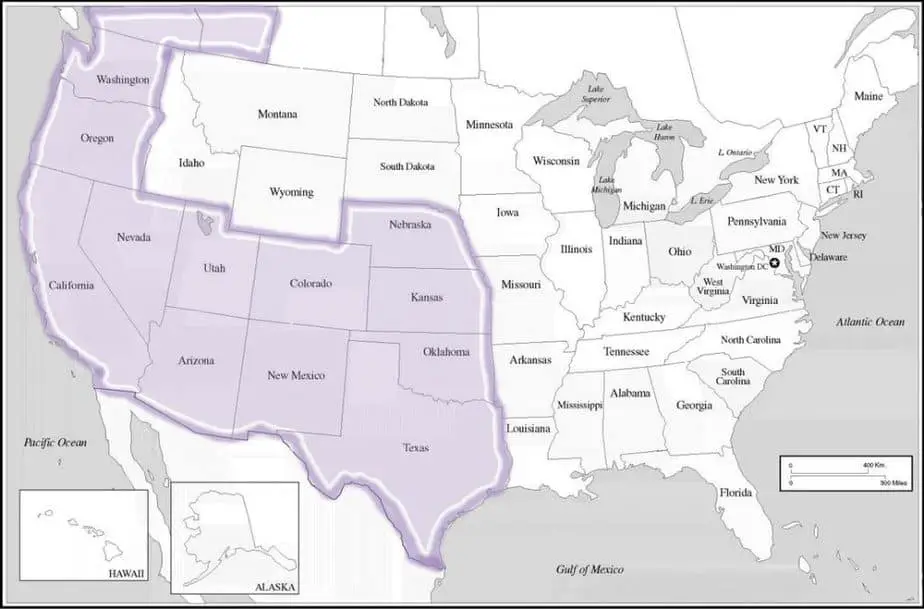
The Western Black Widow can be found throughout the Southern and Western states of the US. Namely, these are the following states: Washington, Oregon, California, Nevada, Utah, Arizona, New Mexico, Colorado, Nebraska, Kansas, Oklahoma, Texas.
Scientific Classification of Latrodectus hesperus
- Kingdom: Animalia
- Phylum: Arthropoda
- Subphylum: Chelicerata
- Class: Arachnida
- Order: Araneae
- Infraorder: Araneomorphae
- Family: Theridiidae
- Genus: Latrodectus
- Species: Latrodectus hesperus


I found this spider on a screen door in Grants Pass Oregon. I was able to look at the belly and was shocked to find a very clear and bright yellow hourglass on the abdomen. Its body is small and legs huge, striped yellow and black, but not hairy.
I can not find any spider like it on the internet to tell me if it is venomous or not. Can you identify it?
Thank you!
~ Kaitlyn =)
Hello Kaitlyn, thanks for getting in touch. This is most definitely a male western black widow (Latrodectus hesperus): https://usaspiders.com/latrodectus-hersperus-western-black-widow/
Male widows are not as venomous as their female counterparts and do usually not deliver medically significant bites. You might want to keep your eyes open for female widows by checking your shoes, pants, etc. It is also not unlikely that the male was just by itself in search of a mate.
I live in Tucson, AZ where we have lots of spiders including black widows. While I don’t want to remove a harmless spider I saw a black spider in this web that appeared on a windowsill but it disappeared into the frame before I could identify it. Can you tell from the web what it might be? I don’t mind harmless spiders in the house. Thank you
Found this guy on a nature walk with my preschoolers under a plank that covered a 1 ft deep hole we had dug. I couldn’t find any pictures of spiders with such distinct markings. Sorry, I don’t have a photo of the eyes, but it was slightly larger than a penny.
Hello Kaden, thanks for getting in touch. I assume you are located somewhere in the Western United States? This looks very much like an immature western black widow (Latrodectus hesperus):
https://usaspiders.com/latrodectus-hersperus-western-black-widow/
Here is an image of a similar spider on Bugguide:
https://bugguide.net/node/view/351712/bgpage
Black widows are medically significant spiders and best observed from a distance.
I think this might actually be a brown widow – Latrodectus geometricus
I lived near Pasadena CA and the black widows were being displaced by brown widows. For the longest time I too thought they were immature black widows, but the egg cases confirmed they were indeed brown widows. Now it’s almost impossible to find a brown widow in the area.
Hello,
My husband discovered this black shiny spider with red marking in the eave of a building at a park in Eastern Oregon. It appeared the other spider in the web was dead. We were trying to determine if it was a male Western Widow? Any insight would be appreciated!
Hello Laura, the living black and red spider is definitely a black widow. Given your location, it is definitely a western black widow (Latrodectus hesperus). The other spider also has the shape of a widow or cobweb spider (Steatoda sp.). My gut feeling tells me that this might be the molt of the living female spider – it appears a little large for a male and the legs of dead spiders are usually retracted. But I could be wrong, it could also be a dead spider.
I found these spiders in my backyard in Arizona. My husband and I are trying to figure out what they are and if we should be concerned.
Hello Amber, thanks for getting in touch! Due to the picture quality, I can’t say for certain that these are black widows, but they do look a lot like black widows. They are generally not really a reason for concern as they are very hesitant to bite humans or larger pets. I’d recommend checking shoes and clothes before putting them on.
Hi, I found this wee bastard climbing ON ME, in the house. It’s dead now. But can you identify it? It looks similar to the immature black widow found by Kaden and his preschoolers.
Hello JV, sorry for the late reply. This is definitely a juvenile western black widow.
I saw this spider hanging out on a stone wall outside of a store in Southern California. The colors were pretty vibrant for the muted tones. Didn’t move too fast when I accidentally say something close to it, and it didn’t have a web that I saw. It was pretty little, as well, maybe the size of a nickel, legs included. Sorry the picture isn’t super clear, I took it with my phone! I’d love to know what it is as I spent some time hanging out with it, haha. And if possible, a gender.
Hello Desirée, thanks for getting in touch! This is a juvenile female western black widow (Latrodectus hesperus): https://usaspiders.com/latrodectus-hesperus-western-black-widow/
This is a medically significant spider, please be careful when relocating her.
Hi! I live in Riverside CA and saw this spider on a stone wall outside of a store. I can’t tell what it is and it didn’t appear to be on or near a web. The pattern is interesting! I know the picture isn’t great but I hope the species and maybe gender can still be identified. Thanks!
Hi Desiree, this is a juvenile female western black widow. The older the spider will get, the darker its body will become. Juvenile black widows are not considered medically significant as the amount of venom they can deliver with a bite is not sufficient to create significant effects on humans or larger pets.
I would still suggest handling this one with care and avoid getting bitten. They can usually be safely relocated with a broom. Here is more information about the western black widow: https://usaspiders.com/latrodectus-hesperus-western-black-widow/
Hi the exterior of my house and garage has many many widows (brown and black) but I have never seen black on with red dots on the back of it like this. I live in FL but it almost seems like a northern black widow from what I’m finding online. It had a red hourglass underneath abdomen. Can you help identify it? Thank you
Under the lip of the bedside table, inches from my head while sleeping. Small, the whole body is less than 1/4 inch long; including legs, approx. 3/4 inch. Prescott, Arizona.
Hello Anne, thanks for getting in touch! This is a male western black widow (Latrodectus hesperus):
https://usaspiders.com/latrodectus-hesperus-western-black-widow/
Unlike the female black widow, the male is not considered medically significant.
Found spider early in the morning with a body smaller then my pinky nail. The color is a brownish-yellow with white spots.
Hello Pat, assuming you are located somewhere in the western United States, this is a male western black widow. Male black widows are not medically significant, while females are. https://usaspiders.com/latrodectus-hesperus-western-black-widow/
Found this gal in the old airbox slot under my motorcycle seat. She was quite aggressive due to the egg sacs she was babysitting. Definitely be careful around these spiders, they can pop up anywhere.
Found this in my storage in Coeur D’Alene, idaho.
Hello Sharee, sorry that it took some time for me to get back to you. This spider appears to be a medically significant black widow – given your location, most likely a western black widow (Latrodectus hesperus): https://usaspiders.com/latrodectus-hesperus-western-black-widow/
Found on some organic grapes that were from Mexico.
Hello Andrew, thanks for getting in touch! This is definitely a widow spider (Latrodectus sp.). Assuming that the grapes originated from Northwestern Mexico, this is most likely a western black widow (Latrodectus hesperus). Western black widows are medically significant – the spider should be handled with care: https://usaspiders.com/latrodectus-hesperus-western-black-widow/
It’s also possible that it is a brown widow (Latrodectus geometricus).
I took pictures of this spider to show all sides but they are not so good.
I will upload one for now and if you want more I can get them to you.
I live in Central Valley, CA and we see black widows and other kinds but this spider was one I didn’t see before. There is a pattern on the back that looks more like a clown face to me than a violin. I came down with wicked deep and painful ankle ulcers around the time we found this spider, and they are still a mystery to the doctors I went to. I feel that identification of the spider would be wise. We watched him/her in a jar which was quite entertaining. We put a fly in the jar and spider got excited but it seemed like it was blind and couldn’t get it
Hello Janet, thanks for getting in touch! This is definitely a male western black widow. The males are not medically significant. It is highly unlikely that the issues on your ankle came from the bite of the spider – even a potentially medically significant bite of an adult female would usually cause systemic issues such as nausea, etc. and does not have any necrotic effects on tissue. Brown recluses might have such an effect, but they are not found in California and their bites are extremely rare.
Here is more information about the western black widow: https://usaspiders.com/latrodectus-hesperus-western-black-widow/
Hello. This spider was found outside of my in-laws home is Mesa Az. It was a rather large spider, roughly bigger than a quarter, I could make out details of its legs and shape of its body from about 20-25 feet away. I can’t seem to find anything remotely close to this spider. No hairs on its legs or body, uniformly dark blackish color, with the markings on its abdomen. Any help is greatly appreciated.
Hi Austin, this is a western black widow spider (Latrodectus hesperus): https://usaspiders.com/latrodectus-hesperus-western-black-widow/
It’s a medically significant spider – a bite can lead to symptoms that require medical attention. Best handle it with care.
What is this?
Hi Bruce, this is a juvenile female black widow. Juveniles are not considered medically significant but it should best be handled with care. The exact species cannot be determined without knowing your location. Judging from the cactus, I would assume you are in the southwestern United States which would make this a western black widow: https://usaspiders.com/latrodectus-hesperus-western-black-widow/
About the size of thumb nail (including legs). Found in S. California
Hello Cheryl, this is a juvenile female black widow (Latrodectus hesperus) – a medically significant spider: https://usaspiders.com/latrodectus-hesperus-western-black-widow/
It’s best to handle this one with care.
If you are interested in learning more about spiders in California, check out our California spider identification and information book – available as an ebook here or as a printed paperback on Amazon.
I found this one in on my back yard patio, in northern California near Davis. Have seen a lot this summer at least 5 or 7 some of them large. Have only killed the ones that get too close to the outside doorways or where they aren’t in plain view of where they are located.
Found this spider while I was at work in Tucson, AZ, opening a wooden tool crate. Bout the size of a typical black widow. Couldn’t find and pictures on the internet that looked like this one. I’m really curious if anyone knows.
Hi Jay, this is a juvenile female western black widow: https://usaspiders.com/latrodectus-hesperus-western-black-widow/
In August 2022, found this spider in between my deck railing and my neighbor’s deck railing. We live in a townhouse in Northern VA.
Saw this small (dime sized) spider in the Sierras in se California. Legs were white and black banded
Hi Jay, this is a juvenile female western black widow: https://usaspiders.com/latrodectus-hesperus-western-black-widow/
If you are interested in learning more about spiders in Washington State, check out our Washington spider identification and information book – available as an ebook here or as a printed paperback on Amazon
Found in central Utah
Hi Ollie, this is a male western black widow: https://usaspiders.com/latrodectus-hesperus-western-black-widow/
The males are not considered medically significant but you should be careful handling this spider and keep an eye out for females.
Found in our new house Pablo Montana. 🤢
Hi Charissa, this is a western black widow – a medically significant spider. Be careful handling the spider to avoid getting bitten. Here is more information about them: https://usaspiders.com/latrodectus-hesperus-western-black-widow/
Is this a Western Black Widow? Found it on the door jamb and moved it along. We’re in Littleton, Colorado.
Sighted on a screen door in Fresno CA, 05.25.23.
Hi Penny, this is a western black widow (Latrodectus hesperus): https://usaspiders.com/latrodectus-hesperus-western-black-widow/